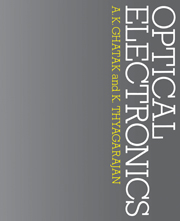Book contents
- Frontmatter
- Contents
- Preface
- 1 Maxwell's equations and propagation of electromagnetic waves
- 2 Reflection and refraction of electromagnetic waves
- 3 Wave propagation in anisotropic media
- 4 Fraunhofer diffraction
- 5 Fresnel diffraction
- 6 Spatial frequency filtering
- 7 Holography
- 8 Lasers: I
- 9 Lasers: II
- 10 Some laser systems
- 11 Electromagnetic analysis of the simplest optical waveguide
- 12 Leaky modes in optical waveguides
- 13 Optical fibre waveguides
- 14 Integrated optics
- 15 The electrooptic effect
- 16 The strain optic tensor
- 17 Acoustooptlc effect: Raman–Nath diffraction
- 18 Acoustooptic effect: Bragg diffraction
- 19 Acoustooptic devices
- 20 Nonlinear optics
- Appendices
- References and suggested reading
- Index
17 - Acoustooptlc effect: Raman–Nath diffraction
Published online by Cambridge University Press: 05 June 2012
- Frontmatter
- Contents
- Preface
- 1 Maxwell's equations and propagation of electromagnetic waves
- 2 Reflection and refraction of electromagnetic waves
- 3 Wave propagation in anisotropic media
- 4 Fraunhofer diffraction
- 5 Fresnel diffraction
- 6 Spatial frequency filtering
- 7 Holography
- 8 Lasers: I
- 9 Lasers: II
- 10 Some laser systems
- 11 Electromagnetic analysis of the simplest optical waveguide
- 12 Leaky modes in optical waveguides
- 13 Optical fibre waveguides
- 14 Integrated optics
- 15 The electrooptic effect
- 16 The strain optic tensor
- 17 Acoustooptlc effect: Raman–Nath diffraction
- 18 Acoustooptic effect: Bragg diffraction
- 19 Acoustooptic devices
- 20 Nonlinear optics
- Appendices
- References and suggested reading
- Index
Summary
Introduction
The acoustooptic effect is the change in the refractive index of a medium caused by the mechanical strain produced by an acoustic wave. Since the strain varies periodically in the acoustic wave, the refractive index of the medium also varies periodically leading to a refractive index grating. When a light beam is incident on such a refractive index grating, diffraction takes place and this produces either multiple order diffraction or only single order diffraction. The former is referred to as Raman–Nath diffraction and is usually observed at low acoustic frequencies. The latter is analogous to Bragg diffraction of X-rays in crystals and is referred to here also as Bragg diffraction; this is usually observed at high acoustic frequencies.
The interaction between acoustic waves and light waves is used in a number of applications such as in acoustooptic modulators, deflectors, frequency shifters for heterodyning, spectrum analysers, Q-switching and mode locking in lasers. In this chapter we will discuss the basic principle of Raman–Nath diffraction and in the next chapter we will discuss Bragg diffraction.
Raman–Nath and Bragg regimes of diffraction
As discussed in the previous section when an acoustic wave propagates in a medium, the periodic strain associated with the acoustic wave generates a periodic refractive index variation in the medium. This periodic refractive index grating has the same period as the acoustic wave and is also propagating at the same velocity as the acoustic wave.
- Type
- Chapter
- Information
- Optical Electronics , pp. 508 - 518Publisher: Cambridge University PressPrint publication year: 1989



